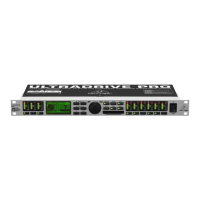18
ULTRADRIVE PRO DCX2496
Fig. 4.40: Out 5 ß Limiter
Use the LIMITER parameter to switch this function ON or OFF.
The corresponding THRESHOLD parameter determines (similarly
to the DYNAMIC EQ) the LIMITER threshold (-24 to 0 dB).
RELEASE controls the recovery time that elapses between the
point when the signal drops below THRESHOLD and the
deactivation of the LIMITER function (20 to 4,000 ms).
4.5.4 POLARITY/PHASE
Any phase errors at the outputs (cancellation of specific
frequency ranges) may be corrected here.
Fig. 4.41: Out 5 ß Polarity/Phase
The POLARITY parameter determines whether the phase of
an output signal is INVERTED or not (NORMAL)just as if you
had inverted the polarity of your speakers. Use the PHASE
parameter to adjust the precise phase position at the upper
X-OVER frequency of the currently selected output. This fine
adjustment is necessary when two output signals are not perfectly
displayed by 0° or 180° with regard to each other
.
4.5.5 DELAY
Fig. 4.42: Out 5 ß Delay
The DLY parameter in the top left corner of the display switches
the DELAY function ON or OFF. With the LINK function you can
couple several output DELAYS, so that you only have to adjust
one DELAY for a whole stack of speakers. However, this applies
to LONG DELAY values only. SHORT DELAY values can be
adjusted separately and independently of the LINK function, and
can be linked to each other in the SETUP menu (page 1/6), using
the parameter OUT STEREO LINK.
The parameters SHORT and LONG allow you to define the
DELAY values of your choice. The setting range for the SHORT
Delay is from 0 to 4,000 mm (= 0.00 to 11.64 ms) and the LONG
Delay can be adjusted from 0.00 to 200.00 m (= 0.00 to 582.24ms).
With the LINK function activated, all LONG DELAY changes at
one output are transferred to the corresponding output (L > M > H
of one stereo side)irrespective of the selected output
configuration (e.g. LMHLMH).
+ If the LINK function is activated for one output, it will be
switched on for ALL other outputs as well.
When you have set all DELAY values for the outputs and then
activated the LINK function for one of them, the LONG DELAY values
are NOT transferred to the linked outputs. This happens only when
you edit any parameters that change the values of the linked outputs
proportionally. The current DELAY values are still not copied, but
rather the linked output values follow the changes.
The output links are shown graphically, with the currently
selected OUT channel displayed as an inverted loudspeaker, in
the top right-hand corner of the display. Below are the DELAY
times shown on a timeline.
4.6 MUTE menu
Fig. 4.43: Mute ß Select
On this page, you can mute individual or all input/output
channels. Use the parameters MUTE ALL OUTS and MUTE ALL
INS to disable (OK) or de-mute (CANCEL) the inputs/outputs of
the DCX2496 in one go. To mute or de-mute individual channels,
please use the respective input/output buttons (e.g. OUT 2, IN A,
SUM, etc.). The lower part of the display only shows the status of
the channel and does not allow for any selection.
MUTE settings of any type can be made exclusively on this
page. As soon as an input/output has been muted, the bottom red
LED above the corresponding input/output button lights up.
Press MUTE again or select another menu to quit the MUTE
menu. Pressing the IN or OUT buttons has no effect.
4.7 RECALL menu
The increasing popularity of portable computer systems such
as notebooks and laptop computers has prompted consumers to
ask for portable and exchangeable storage media to give them a
certain amount of flexibility. In the late 80s a consortium of
manufacturers developed a design, connection and software
standard for memory cards called PCMCIA (Personal Computer
Memory Card International Association). PCMCIA cards have also
become the media of choice in audio engineering, allowing the
user to store data externally via PCMCIA card slots. Today, the
cards are usually referred to as PC cards.
Your ULTRADRIVE PRO DCX2496 has a PCMCIA card slot on
the front panel, allowing you to store your presets easily, without
having to use the internal memory of the device. Use the RECALL
menu to recall previously stored presets (see chapter 4.8)from
the card or from the internal memory.
Fig. 4.44: Recall ß Internal/Card
In the upper display line, the parameter CURRENT NR indicates
the current preset. If the preset has been edited but not yet stored,
an arrow plus EDITED appears below this line. Now, if you try to
load a new preset, the unit warns you that the current preset has
not been saved yet. If you continue to load a new preset, all settings
will be lost.
Fig. 4.45: Recall ß Internal/Card
4. MENU STRUCTURE AND EDITING

